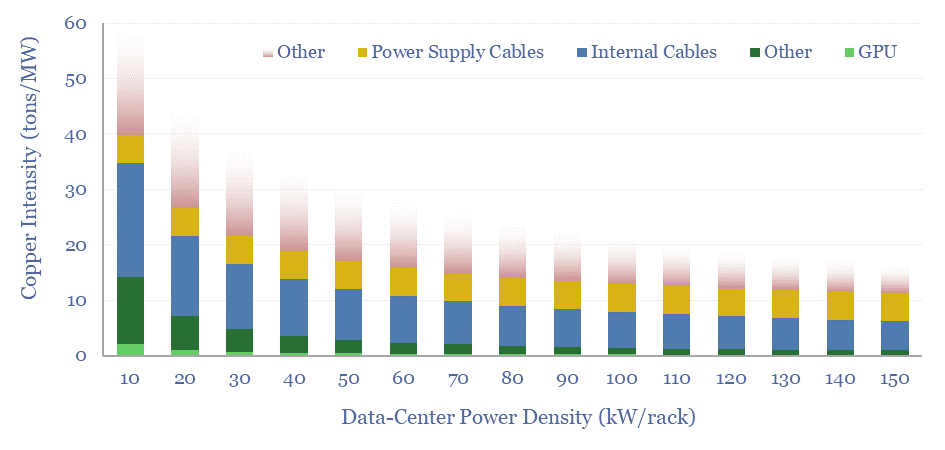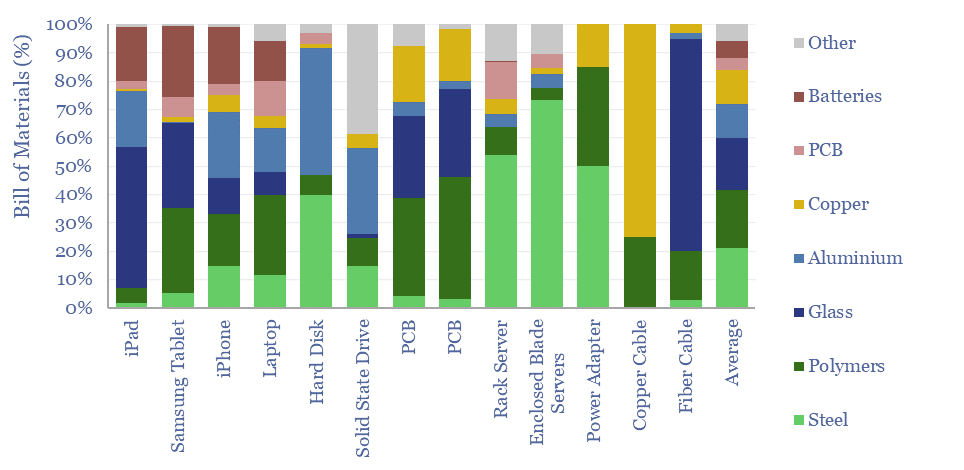Electronic devices are changing the world, from portable electronics to AI data centers. Hence what materials are used in electronic devices, as percentage of mass, and in kg/kW terms? This data-file tabulates the bill of materials, for different devices, across different studies.
This data-file captures the bill of materials for electronic devices, such as cell phones, tablets, laptops, hard discs, solid state-drives, printed circuit boards, servers in data-centers, power supply units, adapters, copper cables and fiber optic cables.
Five materials make up c85% of the mass of typical electronic devices: advanced polymers (c20%), steel (c20%), glass (18%), aluminium (12%) and copper (12%). However, the exact numbers vary by product, as shown in the chart above.
Steel is the joint largest material exposure for electronic devices, although this is unsurprising, as steel is the most-used structural material on the planet, and in digital devices as well, it is used for the chassis/enclosure of data-center racks and other components, in switchgears, fans, heat sinks, etc.
Advanced polymers are the single most important material, both by mass and by specialization. HDPE and PVC are often used for electrical insulation in wires, cables and power supply units. PCBs are c35% epoxy resin. Polycarbonates are used in hard drives and optical disc drives. Solid state drives use specialty polymers, such as liquid crystal polymers.
Copper use from the rise of AI is more debatable. For example, several older studies suggest copper use in AI data-centers can range from 30-60 tons/MW. But on the other hand, these older studies may not fully reflect the scale-up of computing density per rack, which could reduce copper use to 10 tons/MW, albeit this would still tighten global copper balances by around 1% per year through 2030.

The ability to thrift out bulk material intensity factors by raising computing performance density, using advanced materials and manufacturing techniques is highly reminiscent of the same trend in new energies (raising solar efficiency, raising battery voltages). This creates opportunities in vapor deposition equipment, advanced polymers, and ultra-high purity materials including tantalum, silver, gold, tin, et al.
Finally, the vast range of advanced materials used in electronic devices and data-center components is shown by the vast number of materials in the data-file: ABS, Al2O3, Aluminium, Barium, Barium Titanate, Benzoic acid polymer, Brass, Calcium Oxide, Carbon, Cardboard, Chromium, Copper, Cromium, Dioxygen, Epoxy Resin, Ethylene Vinyl Acetate, Fan, Ferrous, Fibrous Glass Wool, Glass, Glass Fiber, Gold, HDPE, HVA-2, Iron, Iron Oxide, LCP Polymer, Lead, Li-ion batteries, Magnesium silicate, Magnesium, Magnets, Manganese, Neodymium, Nickel, Palladium, Paper, PCB, Pegoterate, Phenol polymer, Pigment Black 28, Polybutyl Terephthalate, Polycarbonate, Polycarbonate Acrylonitrile, Polycarbonates, Polyimides, Polymers, Polyurethanes, Proprietary, PVC, Silica, Silicon, Silver, Sodium Oxide, Solder, Steel, Styrofoam, Synthetic Rubber, Tantalum, Tin, Titanium, Vinyl Silicone Oil, Zinc.
